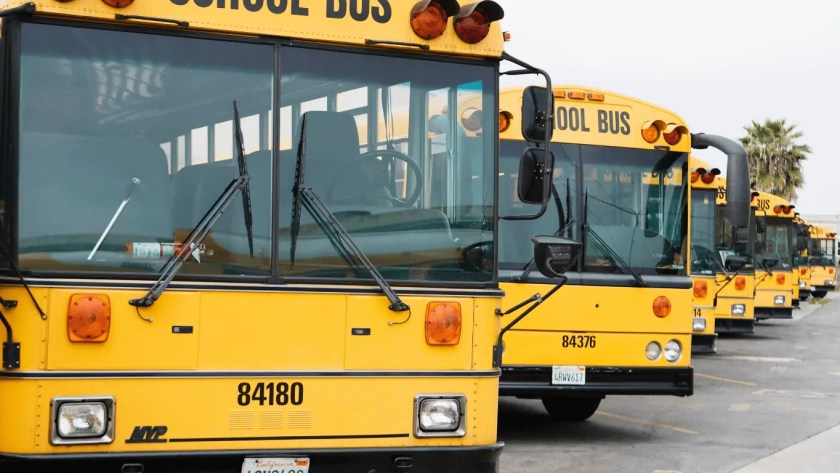
School buses in the United States run on natural gas, diesel fuel, propane, or electricity. There are many different braking techniques that school buses all over the US can use. Read the article to learn more about how each type of bus achieves brake-lock.
Table of Contents
What is the best type of Brakes for a School Bus?
When it comes to brakes, there are a few different types that can be used on school buses. The most common type of brake is the disk brake. Disk brakes are usually made of metal and work by squeezing the disk (or rotor) to create friction. This makes the bus slower or stop.
The second type of brake is the drum brake. Drum brakes look like a cylinder and work similarly to disc brakes, but instead of squeezing a disk, the shoes inside the drum expand outwards. This also creates friction and makes the bus slower or stop.
Disc and drum brakes effectively slow down or stop a school bus. Ultimately, it comes down to personal preference as to which type of brake you want to use on your school bus.
Presta vs. Schrader
There are two types of brakes that you’ll find on school buses: Presta and Schrader. Here’s a quick overview of each type:
Presta valves are more common on road bikes and higher-end mountain bikes. They’re taller and narrower than Schrader valves, making them easier to Pump up to high pressures. They have a small lever that needs to be opened before air can enter the valve and then closed afterward.
Schrader valves are more common on lower-end mountain bikes and BMX bikes. They’re shorter and broader than Presta valves, making them easier to let the air out when you want to adjust your tire pressure. You don’t need a lever to open or close them – push down on the stem to let air in or out.
Drum brakes
Drum brakes are one of the most common brakes found on school buses. Drum brakes pressurize a hydraulic fluid to push two brake shoes against the inner surface of a rotating drum. The friction between the shoes and the drum slows down the wheel’s rotation.
Most school buses have rear-wheel drum brakes, although some may also have front-wheel drum brakes. Drum brakes are generally less expensive than other brakes, such as disc brakes, and are also easier to maintain. However, they can be less effective in wet weather and are more likely to experience brake fade (reduced stopping power) over time.
Front-wheel brakes
The front wheel brakes on school buses are designed to provide the reliable stopping power and fade resistance. These brakes are typically either disc or drum type, with the former being more common on newer buses. Both brakes use a hydraulic system to apply pressure to the brake pads or shoes, which grips the rotating brake drums or discs to stop the wheel from turning.
Rear wheel brakes
As the name suggests, rear wheel brakes are located on the back wheels of a school bus. These brakes are essential because they help to slow down and stop the bus when necessary.
Rear wheel brakes use friction to slow down the bus’s wheels. When the driver applies pressure to the brake pedal, this pressure is transferred to the rear wheels through a hydraulic system. The hydraulic system then applies pressure to the brake pads, which press against the rotors on the reels. This friction between the pads and rotors slows down the wheels’ rotation, eventually bringing the bus to a stop.
There are several benefits of rear wheel brakes over other types of brakes. First, they are very effective at slowing down and stopping a bus. Second, they wear evenly, which means they don’t need to be replaced as often as other brakes. Finally, they’re less likely to cause skidding or sliding when used in wet or icy conditions.
Airbrakes
Two types of brakes can be found on school buses: air and hydraulic. Air brakes are the most common type of brake used on school buses. Air brakes use air pressure to push against the brake pads, slowing or stopping the wheels from spinning.
Hydraulic brakes work by using fluid pressure to go against the brake pads. Both brakes are effective at slowing or stopping a school bus, but air brakes are generally considered more reliable and easier to maintain than hydraulic brakes.
FAQ on brakes used in school bus
What types of brakes are used on school buses?
The type of brakes used on a school bus can vary depending on the make and model of the bus. However, the air brake is the most common brake on a school bus. Air brakes use compressed air to stop the wheels from turning, which ultimately slows down and stops the bus.
How do air brakes work?
Air brakes use compressed air to push against the Brake Pads, which press against the Rotors. The pressure from the compressed air forces the pads against the rotors, slows down the wheel’s rotation, and eventually causes the bus to stop.
Are there other brakes that can be used on a school bus?
In addition to air brakes, some school buses also have hydraulic brakes. Hydraulic brakes work similarly to air brakes, but instead of using compressed air, they use hydraulic fluid to push against the brake pads and slow down the wheels.